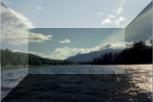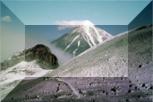
Petropavlovsk-Kamchatsky

Southern volcanoes track

River Bystraya

Avachinsky volcano
 Petropavlovsk-Kamchatsky |
 Southern volcanoes track |
 River Bystraya |
 Avachinsky volcano |
|---|
|
Kamchatka is a mysterious country. It's a very difficult to get any information about this
peninsula in the Far East of Russia. Despite of my many affords to collect some reliable
information about Kamchatka from different sources, including the Russian books and
internet pages, arrived in Kamchatka I had only a vague imagination, what and where I can do there.
The journey to Kamchatka comparing to my other travels was for me like a leap in the
dark.
The remote peninsula at the Pacific coast of Siberia was a long time a forbidden land. Because of their nearness to American continent it was the home for the most important military base of Soviet Union in the Pacific region. Even for the citizens of the Soviet Union was it difficult to get a permit to come to the peninsula. After Perestroyka it was possible for the foreigners to visit Kamchatka. Unfortunately along with the lack of amenities or transportation network outside of the city, Kamchatka travel is complicated by a certain comprehension gap. Kamchatka was completely isolated from the West for so long that locals have very little concept of low-budget, low-impact wilderness adventure. Their impressions of what foreign visitors want, and can pay, has been formed by the first foreign tourists to hit Kamchatka: sport hunters who pay $10,000 to $20,000 each, demand to be pampered, and leave behind expensive equipment and gifts. |
|

|
Kamchatkans as a rule are very warm, hospitable people, but Kamtschatka's official policies
toward tourists have been anything but welcoming. As the peninsula's tight seal began to crack,
Party bureaucrats grasped control of "tourist reception", demanding exorbitant fees for everything
from a permit to climb volcanoes to filming wilderness documentaries. Notwithstanding
arguments about a country or region's right to charge visitors for the enjoyment of its
wilderness resources, in Russia funds collected for this purpose usually benefit the individuals
extorting them rather the regional economy or supporting natural resource management.
The biggest obstacle to growth of a stable tourist industry on Kamchatka that would facilitate travel there and provide tourism income to the region is the lack of the independent tourist agencies to compete in providing services at reasonable prices. For example there is only one helicopter company allowed to organize flights over the peninsula. Because of this monopoly the prices for a helicopter fly are extremely high. The exaggerated high prices were the reason, why I didn't visit the most spectacular places on the peninsula: the Valley of Geysers, the scenic Uzon Caldera or the area around the Lake Kurylskoye, with the highest bears and salmon population of the world. Therefore I can't be fully satisfied with my Kamchatka travel. |
|
The peninsula is not easy place to travel independently. Even the hike of Avachinskaya Sopka,
right out of Petropavlovsk-Kamchatsky, is challenging to arrange on your own unless you have
friends with an all-terrain vehicle. For anyplace farther away, hiring a helicopter or truck is
a virtual necessity; as elsewhere, it is prohibitively difficult and expensive to do this without
going through an organized tour agency. The other hindrance is a lack of reliable maps.
The remoteness of Kamchatka and their state as prohibited military area helped to save their pristine nature. The beauty of the peninsula is worth to visit it and Kamchatka is predisposed to stay one of the world's biggest centers for the outdoor travelers. Improvements in the touristic infrastructure and more competition between the tourism agencies, resulting in moderate prices for their services, would attract hundred thousands travelers to the country, and open additional source of income for the big parts of the peninsula's population. |
|

|